lZr
L&M
I am very happy to mark my final conclusion about Diafine its push ability and Tri-X.
Today I developed my last roll, shoot at 800/1000 (Bessa R subdivisions between 400 and 1000) and I was surprised every respect. Gorgeous contrast, excellent shadows and good highlights.
So, I can say, I have a pair developer/film that can be set any ISO between 400 and 1600 in the middle of the roll at any time and successfully be scanned to get fine result. Not excellent, but very good. I need one like that, because in my country the sun can overule the f/16 very easy and the light condition changing very fast
Today I developed my last roll, shoot at 800/1000 (Bessa R subdivisions between 400 and 1000) and I was surprised every respect. Gorgeous contrast, excellent shadows and good highlights.
So, I can say, I have a pair developer/film that can be set any ISO between 400 and 1600 in the middle of the roll at any time and successfully be scanned to get fine result. Not excellent, but very good. I need one like that, because in my country the sun can overule the f/16 very easy and the light condition changing very fast






